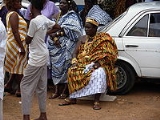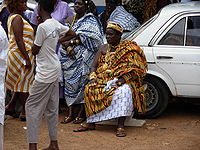
Akan Chieftaincy
Encyclopedia

West Africa
West Africa or Western Africa is the westernmost region of the African continent. Geopolitically, the UN definition of Western Africa includes the following 16 countries and an area of approximately 5 million square km:-Flags of West Africa:...
, there is an old chieftaincy tradition. The Akan of Ghana
Akan people
The Akan people are an ethnic group found predominately in Ghana and The Ivory Coast. Akans are the majority in both of these countries and overall have a population of over 20 million people.The Akan speak Kwa languages-Origin and ethnogenesis:...
have developed their own hierarchy which exists aside the democratic
Democracy
Democracy is generally defined as a form of government in which all adult citizens have an equal say in the decisions that affect their lives. Ideally, this includes equal participation in the proposal, development and passage of legislation into law...
structure of the country. The Akan word for the ruler is nana. In colonial times, Europeans translated it to “chief”, which is not equivalent. Other sources speak of “kings”, which is also not correct. The term “chief” has naturalized nowadays, though it would be more exact to use the Fante expression nana.
History
The roots of Akan chieftaincy are unknown. Written sources are scarce. When the Akan were settling in the Tekyiman Region, i.e. before 1300, they already had the chieftaincy system for long. The Paramount Chief had a position which can be compared to that of an absolutistAbsolute monarchy
Absolute monarchy is a monarchical form of government in which the monarch exercises ultimate governing authority as head of state and head of government, his or her power not being limited by a constitution or by the law. An absolute monarch thus wields unrestricted political power over the...
king.
When the Republic of Ghana was founded in 1957, it was agreed that the chieftaincy system should be respected.
Present time
Chieftaincy is officially accepted. Politicians ask chiefs for advice because usually they are closer to the people. The highest committee is the National House of Chiefs in AccraAccra
Accra is the capital and largest city of Ghana, with an urban population of 1,658,937 according to the 2000 census. Accra is also the capital of the Greater Accra Region and of the Accra Metropolitan District, with which it is coterminous...
. There are also Regional Houses of Chiefs. In case of problems between the chiefs, the House of Chiefs has a legal function.
Hierarchy
The highest rank is that of a Paramount chief. Within the Akan people, there are different sub-groups, like the Ashanti or the Fante. The Ashanti have only one paramount chief, the asantehene. The present Asantehene is Otumfuo Nana Osei Tutu IIOtumfuo Nana Osei Tutu II
King Otumfuo Osei Tutu, is the 16th Asantehene, King of the Ashanti. He ascended the Golden Stool on 26 April 1999. By name, he is in direct succession to the founder of the Empire of Ashanti, Otumfuo Osei Tutu I.-Family:...
. Foreign guests of state usually visit the president and the Asantehene. The Fante have several Paramount Chiefs with very small territories. So the influence of the Fante Paramount Chief is comparatively small.
Underneath the Paramount chiefs, there are Chiefs and subchiefs. A subchief can be compared to the mayor
Mayor
In many countries, a Mayor is the highest ranking officer in the municipal government of a town or a large urban city....
of a village. The chiefs have their own territory, and apart from that, they have a function at court. Most of the functions are traditional, some have been created recently:
A chief arbitrates
Arbitration
Arbitration, a form of alternative dispute resolution , is a legal technique for the resolution of disputes outside the courts, where the parties to a dispute refer it to one or more persons , by whose decision they agree to be bound...
and decides political and economic questions in his area. When he is installed, he receives a stool name. Usually, all chief on one stool have the same name – a number is added.
Ankobeahene
Ankobea means one who stays at home or does not go anywhere. Ankobeahene is the caretaker of the palace.Obaatan
Obaatan means "parent". His symbol is the egg out of which all other chiefs came. He is Omanhene's counsellor. When Omanhene's stool is vacant, Obaatan suggests the next candidate.Tofuhene
The "warrior" is the head of the Asafo companies.The 'Tofuhene or Tufohene' is also the Chief Adviser to the Chief.
The meaning of Tufo in Akan language is ADVISE.
Adontehene
There are four positions describing military flanks. Adontehene is the one who goes in front of the army.Nkyidom
Nkyidom is the last going. He collects the soldiers who are left behind and sends them back to the army. During Odambea, Nkyidom always sits in the last palanquin.Mankrado
Mankrado's function is purification. He puts leaves into the water which he sprinkles over omanhene. He always has salt in his pocket to make things taste better for Omanhene.Guantuahene
The function of Guantuahene is younger than ten years. Guantoahene is the one people can turn to for shelter and mercy.Nsumankwahene
Nsumankwahene watches the oracle. This function is also younger than ten years.Nkosuohene
Nkosuohene is responsible for the development of the region. The title is in use since about ten years and was adopted from the Ashanti who had made it up before. This title was created to honour someone who does not have to be member of a royal family. There are some foreigners who have been honoured with this title.Entourage
The most important person in the chief's entourage is the priest or priestess (okomfo). Traditionally, the priest tells the chief when it is for example time to start a war or to marry.There is also a stool wife. No matter if a chief is married or not, when installed, he will be married to a very young girl. Nowadays, it is not obligatory, though polygamy
Polygamy
Polygamy is a marriage which includes more than two partners...
is still legal. Today, the symbolic act is sufficient: During parades, a stool wife is sitting in front of the chief.
A chief has one or more linguists (okyeami, sg.). A chief never talks in public, but conveys messages through his linguist who is also responsible for the pouring of libations.
Queen Mother
The title of Queen mother can relate to the rank of a paramount queen, a queen or a sub-queen. The Akan name is the same as for the men, “nana”. When using English, Ghanaians say “queen mother”. This woman is not necessarily the respective chief's mother. Her role in the system is to have an eye on the social conditions, and a personally capable Queen mother has been known to equal or even surpass a reigning Chief in terms of power and prestige. A good example of this happening is the case of Queen Yaa Asantewa.Personal Ornaments
On occasions, chiefs wear the traditional cloth, which is a six yards long piece of fabric, wrapped around the body. Female chiefs have two pieces of fabric which can be of different design.The jewellery is very ample and used to be of gold. Nowadays, most chiefs are wearing imitations. The Head-Dress usually has the form of a crown. It can be made of metal or of black velvet, ornamented with metal. Chiefs have traditional sandals, and the wearing of sandals is symbolic. When a chief abdicates, he puts off his sandals.
Fly-whisk
When riding in a palanquin, chiefs hold a fly-whiskFly-whisk
A fly-whisk is a tool to swat or disturb flies. It is used as a regalia in some cultures.In Indonesian art, a fly-whisk is one of the items associated with Shiva. The fly-whisk is frequently seen as an attribute of both Hindu, Daoist, and Buddhist deities...
in one hand and a ceremonial sword in the other. The fly-whisk is made of animal hair.
Sword
The ceremonial short sword is used for animal sacrifice. The chiefs touches the animal's throat symbolically with his sword before someone else cuts the throat with a sharp knife.Palanquin
During a Durbar, which is a special parade, some chiefs are carried in a palanquin. Subchiefs have to walk. The palanquins can have the form of a chair or of a bed.Stool
Instead of a throne, Akan Chiefs are sitting on a stool. When they die, their stool is painted black and stored in a sacred room.Umbrella (Bamkyim)
Very big umbrellas made of silk and other rich fabrics show from afara that a chief is coming.Sources
As there is not much written information, oral sources have to be quoted:- Mr. Anthony Alick Eghan, Yamoransa (Central Region, Ghana)
Literature
- Antubam, Kofi; Ghana's heritage of Culture, Leipzig 1963
- Kyerematen, A.A.Y.; Panoply of Ghana, London 1964
- Meyerowitz, Eva L. R.; Akan Traditions of Origin, London (published around 1950)
- Meyerowitz, Eva L. R.; At the court of an African King, London 1962
- Obeng, Ernest E.; Ancient Ashanti Chieftaincy, Tema (Ghana) 1986

